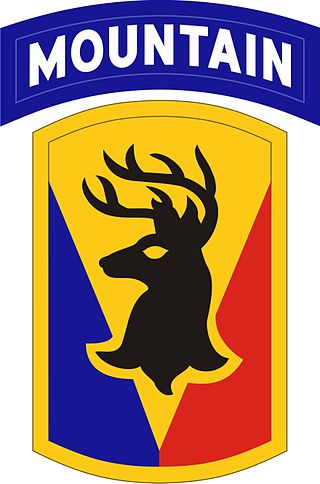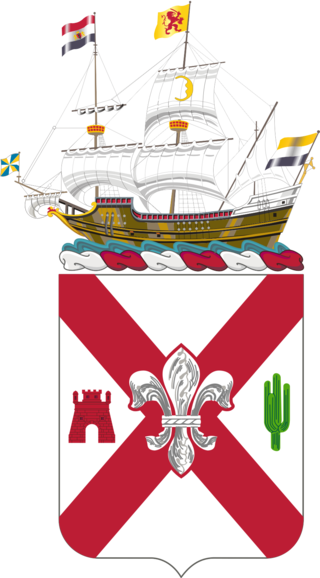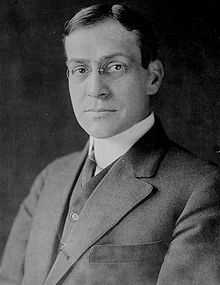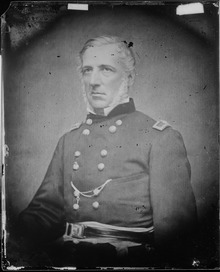
United States Colored Troops (USCT) were Union Army regiments during the American Civil War that primarily comprised African Americans, with soldiers from other ethnic groups also serving in USCT units. Established in response to a demand for more units from Union Army commanders, by the end of the war in 1865 USCT regiments, which numbered 175 in total, constituted about one-tenth of the manpower of the army. Approximately 20 percent of USCT soldiers were killed in action or died of disease and other causes, a rate about 35 percent higher than that of white Union troops. Numerous USCT soldiers fought with distinction, with 16 receiving the Medal of Honor. The USCT regiments were precursors to the Buffalo Soldier units which fought in the American Indian Wars.

The American Expeditionary Forces (AEF) was a formation of the United States Armed Forces on the Western Front during World War I, comprised mostly of units from the U.S. Army. The AEF was established on July 5, 1917, in France under the command of then-Major General John J. Pershing. It fought alongside French Army, British Army, Canadian Army, British Indian Army, New Zealand Army and Australian Army units against the Imperial German Army. A small number of AEF troops also fought alongside Italian Army units in 1918 against the Austro-Hungarian Army. The AEF helped the French Army on the Western Front during the Aisne Offensive in the summer of 1918, and fought its major actions in the Battle of Saint-Mihiel and the Meuse-Argonne Offensive in the latter part of 1918.

The 369th Infantry Regiment, originally formed as the 15th New York National Guard Regiment before it was re-organized as the 369th upon its federalization and commonly referred to as the Harlem Hellfighters, was an infantry regiment of the New York Army National Guard during World War I and World War II. The regiment mainly consisted of African Americans, but it also included men from Puerto Rico, Cuba, Guyana, Liberia, Portugal, Canada, the West Indies, as well as white American officers. With the 370th Infantry Regiment, it was known for being one of the first African-American regiments to serve with the American Expeditionary Forces during World War I.

The 77th Sustainment Brigade is a unit of the United States Army that inherited the lineage of the 77th Infantry Division, which served in World War I and World War II. Its headquarters has been at Fort Dix, New Jersey, since its predecessor command, the 77th Regional Readiness Command, was disestablished in 2008 from Fort Totten in Bayside, Queens, New York. Soldiers from the 77th have served in most major conflict and contingency operations since World War II.

The 93rd Infantry Division was a "colored" segregated unit of the United States Army in World War I and World War II. However, in World War I only its four infantry regiments, two brigade headquarters, and a provisional division headquarters were organized, and the divisional and brigade headquarters were demobilized in May 1918. Its regiments fought primarily under French command in that war and saw action during the Second Battle of the Marne. They acquired the nickname Blue Helmets from the French, as these units were issued horizon blue French Adrian helmets. Consequently, its shoulder patch became a blue French helmet, to commemorate its service with the French Army during the German spring offensive.

The 43rd Infantry Division was a formation of the United States Army from 1920 to 1963, serving in the Pacific during World War II. It was activated in 1920 as a National Guard Division in Connecticut, Maine, Rhode Island, and Vermont. The 143rd Regional Support Group of the Connecticut National Guard now carries on the heritage.

The 42nd Infantry Division (42ID) ("Rainbow") is a division of the United States Army National Guard. It was nicknamed the Rainbow Division because, during rapid mobilization for service in WW1, it was formed from 27 National Guard units from across the US. The division was engaged in four major operations between July 1918 and the armistice in November 1918, and demobilized in 1919. Since World War I, the 42nd Infantry Division has served in World War II and the Global War on Terrorism (GWOT).

The 27th Infantry Division was a unit of the Army National Guard in World War I and World War II. The division traces its history from the New York Division, formed originally in 1908. The 6th Division designation was changed to the 27th Division in July 1917.

William Henry Johnson, commonly known as Henry Johnson, was a United States Army soldier who performed heroically in the first African American unit of the United States Army to engage in combat in World War I. On watch in the Argonne Forest on May 14, 1918, he fought off a German raid in hand-to-hand combat, killing multiple German soldiers and rescuing a fellow soldier while suffering 21 wounds, in an action that was brought to the nation's attention by coverage in the New York World and The Saturday Evening Post later that year. On June 2, 2015, he was posthumously awarded the Medal of Honor by President Barack Obama in a ceremony at the White House.

The New York Army National Guard is a component of the New York National Guard and the Army National Guard. Nationwide, the Army National Guard comprises approximately one half of the United States Army's available combat forces and approximately one third of its support organization. National coordination of various state National Guard units are maintained through the National Guard Bureau.

The South Carolina Army National Guard is a component of the United States Army and the United States National Guard. Nationwide, the Army National Guard comprises approximately one half of the U.S. Army's available combat forces and approximately one third of its support organization. National coordination of various state National Guard units is maintained through the National Guard Bureau.

The 53rd Troop Command is an administrative headquarters of the New York Army National Guard that provides direction for units not under another brigade or other formation headquarters (HQ). It also provides administrative support to units from other formations in the New York area that are stationed a long way from their higher HQ.

The 86th Infantry Brigade Combat Team (Mountain) ("The Vermont Brigade") is an Army National Guard light infantry brigade headquartered in Vermont. It was reorganized from an armored brigade into an Infantry Brigade Combat Team (IBCT) as part of the United States Army's transformation for the 21st century. The 86th IBCT utilizes the Army Mountain Warfare School, co-located at Ethan Allen Firing Range in Jericho, Vermont, to train in individual military mountaineering skills so the entire brigade can be skilled in such warfare. This large conventional unit level mountain warfare capability had been lost when the 10th Mountain Division deactivated after World War II. This left the 86th IBCT as the only mountain warfare unit in the U.S. military whose soldiers were trained in mountain warfare, with individual soldiers being graduates of Ranger School, the Special Forces Advanced Mountain Operations School, and the Army Mountain Warfare School instead of entire units that specialized in such tactics. "The Vermont Brigade" configured itself to be such a unit.

A pioneer is a soldier employed to perform engineering and construction tasks. The term is in principle similar to sapper or combat engineer.

The 26th Infantry Division was an infantry division of the United States Army. A major formation of the Massachusetts Army National Guard, it was based in Boston, Massachusetts for most of its history. Today, the division's heritage is carried on by the 26th Maneuver Enhancement Brigade.

The 42nd Infantry Division Sustainment Brigade is a United States Army sustainment brigade of the 42nd Infantry Division of the New York Army National Guard headquartered out of the 369th Regiment Armory in Harlem, New York. This unit is descended from the 369th Infantry Regiment.

The 108th Infantry Regiment is a regiment of the New York Army National Guard. It was first formed in 1898 and has been in continuous existence since 1907. As National Guardsmen, Soldiers of the 108th Infantry can be called upon to serve the state and federal governments. The 108th has served in the Spanish–American War, the Mexican Border War, World War I, World War II, Iraq, and Afghanistan.

The Harlem Hellfighters is a graphic novel written by author Max Brooks with illustrations done by Caanan White. It is a fictionalized account of the experiences of the largely African American 369th Infantry Regiment, nicknamed the "Hell-fighters" by German soldiers, during the First World War.

The 174th Infantry Regiment was an infantry regiment of the United States Army, New York Army National Guard. It traced its heritage back to the 74th New York State Militia formed in Buffalo in 1854. It was deactivated in 1945.

Camp Hyder was a US Army installation in Arizona, functioning as a subcamp of the Desert Training Center in Riverside County, California. The main headquarters for the Desert Training Center was Camp Young, this is where General Patton's 3rd Armored Division was stationed. Camp Hyder is 2 miles (3.2 km) miles south of Hyder, Arizona. The camp was just north of the Gila River. Camp Hyder is 60 miles (97 km) miles east of Yuma, Arizona, near Camp Horn. Camp Hyder was built at the site of an old 1890s military base. Trained at Camp Hyder, in 1943, for six months was the 77th Infantry Division from April 1943 to September 1943. Then the 104th Infantry Division moved in for training. Unlike the other camps, no large tank activity was done. The camp was built by The 369th Engineer Regiment. Camp Hyder had its own rail station at which most troops arrived. The train station at Sentinel, Arizona south of the camp was also used. Over 13,000 troops were trained at Camp Horn and Camp Hyder.

























